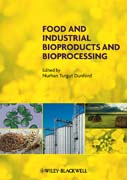
Food and Industrial Bioproducts and Bioprocessing describes the engineering aspects of bioprocessing, including advanced food processing techniques and bioproduct development. The main focus of the book is on food applications, whilenumerous industrial applications are highlighted as well. The editors and authors, all experts in various bioprocessing fields, cover the latest developments in the industry and provide perspective on new and potential products and processes. Challenges and opportunities facing the bioproduct manufacturing industry are also discussed. Coverage is far-reaching and includes: current and future biomass sources and bioprocesses; oilseed processing and refining; starch and protein processing; non-thermal food processing; fermentation; extraction techniques; enzymatic conversions; nanotechnology; microencapsulation and emulsion techniques; bioproducts from fungi and algae; biopolymers; and biodegradable/edible packaging.Researchers and product developers in food science, agriculture, engineering, bioprocessing and bioproduct development will find Foodand Industrial Bioproducts and Bioprocessing an invaluable resource. INDICE: Preface xiContributors xiiiAbbreviations xvii1 Traditional and Emerging Feedstocks for Food and Industrial Bioproduct Manufacturing 1Nurhan Turgut Dunford1.1 Introduction 11.2 Grain crops 21.3 Oil and oilseeds 131.4 Lignocellulosic biomass 241.5 Conclusions 252 Recent Processing Methods for Preparing Starch-based Bioproducts 37George F. Fanta, Frederick C. Felker and Randal L. Shogren2.1 Introduction 372.2 Annealing and heat-moisture treatment 402.3 High-pressure treatment 412.4 Microwave processing 462.5 Processes using ultrasound 502.6 Processing using supercritical fluids 562.7 Extrusion processing 632.8 Processing by steam jet cooking 672.9 Conclusions 713 Protein Processing inFood and Bioproduct Manufacturing and Techniques for Analysis 85Joyce Irene Boye and Chockry Barbana3.1 Introduction 853.2 General properties of proteins 863.3 Protein separation processes in food and bioproduct manufacturing 873.4 Calculating protein yields and recovery 1013.5 Processing effects on yield and protein quality 1013.6 Conclusion 1084 Advancements in Oil and Oilseed Processing 115Nurhan Turgut Dunford4.1 Introduction 1154.2 Oilseed pretreatment 1164.3 Oil extraction 1194.4 Oil refining 1274.5 Conclusions 1375 Food-grade Microemulsions As Nano-scale Controlled Delivery Vehicles 145Natasha Berry, Rickey Yada and Dérick Rousseau5.1 Introduction 1455.2 Winsor classification/phase behavior 1465.3 Theories of microemulsion formation 1475.4 What makes microemulsions thermodynamically stable? 1485.5 Methods of microemulsion formation 1485.6 Polydispersity 1495.7 Composition 1495.8 Factors affecting phase behavior 1515.9 Parameters that modify microemulsion structure 1525.10 Characterization techniques 1545.11 Applications 1585.12 Conclusions 1606 Emulsions, Nanoemulsions and Solid Lipid Nanoparticles as Delivery Systems in Foods 167Umut Yucel, Ryan J. Elias and John N. Coupland6.1 Delivery systems in foods 1676.2 Structure of emulsions 1686.3 Localization of BLI in emulsions 1696.4 Emulsions as delivery systems 1726.5 Crystallization in emulsions 1746.6 Localization of BLI in solid lipid nanoparticles 1786.7 Conclusions 1807 Fermentation 185Mark R. Wilkins and Hasan Atiyeh7.1 Introduction 1857.2 Fermentative pathways 1867.3 Microbial growth 1887.4 Reactor design 1897.5 Fermentation schemes 1947.6 Fermentation Products 1957.7 Separation 1997.8 Future application areas and emerging developments 2008 Fungal Cell Factories 205Sue A. Karagiosis and Scott E. Baker8.1 Fungi and fungal biotechnology 2058.2 Historical perspective 2068.3 Industry 2088.4 Genomics and the future 2138.5 Conclusions 2159 Microalgae: A Renewable Source of Bioproducts 221Susan I. Blackburn and John K. Volkman9.1 Introduction 2219.2 Microalgae and their global importance 2219.3 Cultured microalgae 2239.4 Algal culture collections 2249.5 Microalgal production systems 2259.6Historical natural foods 2289.7 Live feedstocks for aquaculture 2289.8 Bioproducts 2299.9 Pharmaceuticals 2359.10 Microalgae in cosmetics and skin care 2369.11 Microalgae bioproducts: Future potential 23610 Bioprocessing Approaches to Synthesize Bio-based Surfactants and Detergents 243Douglas G. Hayes10.1 Bio-based surfactants: Overview 24310.2 Feedstocks for bio-based surfactants 24410.3 Industrial bio-based surfactants 24610.4 Advantages of bioprocessing to prepare bio-based non-ionic surfactants 24810.5 Preparation of bio-based surfactants via enzymes in non-aqueous media 24910.6 Preparation of biosurfactants viafermentation 25810.7 Conclusions 26111 Biopolymers 267Oguz Turünc and Michael A. R. Meier11.1 Introduction 26711.2 Carbohydrate-based polymers 26711.3 Fat- and oil-based polymers 27711.4 Conclusion 28612 Lignocellulosic Biomass Processing 293Fei Yu and Jonathan Y. Chen12.1 Introduction 29312.2 Availability oflignocellulosic biomass 29312.3 Processing 29713 Recent Developments in Non-thermal Processess 313Fernando Sampedro and Howard Q. Zhang13.1 Introduction 31313.2 Recent advances in non-thermal technologies 31413.3 Future trends 32514 Enzymes as Biocatalysts for Lipid-based Bioproducts Processing 333Ling-Zhi Cheong, Zheng Guo, Sergey N. Fedosov, Bena-Marie Lue, Ram C.R. Jala, Gündüz Güzel, and Xuebing Xu14.1 Introduction 33314.2 Enzyme characteristics 33314.3 Enzyme kinetics in industrial applications 33414.4 Enzymes in industrial applications 33814.5 Conclusions and future trends 351References 353Index 359A color plate section falls between pages 222 and 223
- ISBN: 978-0-8138-2105-4
- Editorial: Iowa State University
- Encuadernacion: Cartoné
- Páginas: 392
- Fecha Publicación: 26/03/2012
- Nº Volúmenes: 1
- Idioma: Inglés
